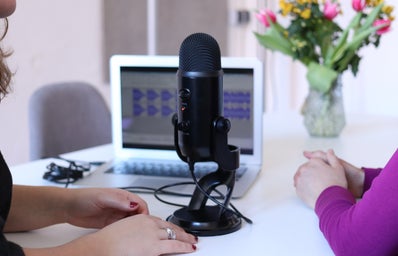So you want to start a podcast, well that makes you one of many. From 2018 to 2021, the number of active podcasts available increased by 70% from 500 000 to 850 000. I myself am included in that statistic. In August of 2020, after a few months of toying with the idea, my friend and I finally decided to apply to Ryerson University’s Spirit Live Radio station with our pitch for Unpacked Podcast. Unpacked Podcast is a feminism centric show that addresses relevant social phenomena and unpacks trending cultural topics using critical analysis and feminist theory. Our show was accepted and ever since then, we’ve been recording and releasing episodes by-weekly on Apple and Spotify with Spirit Live.
Armed with some limited podcasting experience and a podcast addiction that is borderline unhealthy, I present to you the necessary steps one should take before they embark on their journey into the long-form audio industry, to ensure you produce a catalogue of episodes that you can be proud of in this highly saturated market.
WHY do you want to start a podcast?
What is it you want to get out of creating a podcast? Are you creating it to accompany or publicize another piece of work? Is it to gain experience and portfolio content? Is it to draw attention to an important issue? This can be considered your mission Statement. For example, when starting Unpacked, my co-host and I sat down and decided that the mission for our content would be to create dialogue in the feminist movement that addressess relevant topics as they relate to feminist theory while advocating for nuance in the conversation around female issues. Or to boil it down to three simple words; inclusion, education and dialogue.
Do you actually have something to say? – The WHAT
Now though it might not seem so, this question and the previous one are actually asking something different. You may have an interesting or noble reason for why you want to start a podcast, but if you don’t really have anything relevant or engaging to talk about, then it will be difficult to get the wheels off of the ground. The easiest place to start when deciding on the central theme for your podcast is to reflect on what you are passionate about, what is either, something you know quite a bit about or something you are interested in learning more about.
If you’re hoping to get more than a few episodes out of your podcast, then it’s important to develop your show around a broader topic that has multiple avenues for growth within the subject. For example, under the broader topic of feminism, there are multiple directions to go for discussion and a deep well of information to source. If your central theme is too narrow or specific, you will struggle to create new dialogue around the topic each week.
Invest in the right tech!
In the highly saturated podcast market today, when it comes to the technical aspect of your podcast, anything that strays drastically from the industry standard, doesn’t have much chance at competing with the top players on Spotify and Apple Podcasts. While you will have to invest in good quality gear, consumer recording has become much more accessible and affordable in the last few years. Once upon a time you needed a recording studio and now all that it takes to record a podcast is a decent microphone, a laptop and quiet space.
-
Microphones: This will likely be the most expensive part of your podcast equipment. Good quality and reasonably priced consumer microphones on the market at the moment range between $70-$250. I would recommend the Blue Yeti USB microphone or the SnowBall iCE microphone. Trust me, it’s worth it. Just bite the bullet and you will be glad you did later.
-
Headphones: The next most important piece of equipment in your kit is a good pair of headphones. The best quality consumer headphones on the market at the moment range between $100-$400, any higher than that and you really start to get into the professional market. While you don’t need a $400 pair of headphones to start a podcast, it can be really helpful to have a pair of noise cancelling headphones while you’re recording. If you’re recording with another person, it helps to balance out your audio and minimize aural distractions. Post-production is where the difference between your apple cord earpods and pair of good quality over-the-ear headphones becomes very apparent. The intricacies in voices, monitoring levels and getting an accurate read of how the audience is going to hear the final product, all becomes more difficult when you’re not listening to the audio in its purest form or close to. I personally use the Sennheiser HD 280 Pro. They cost me about $150.00 when I bought them and they’ve worked great for me so I use them all the time, even when I’m not recording.
-
Location: Where you choose to record is crucial to the quality of your output. If your recording environment is noisy (people chatting, music playing, traffic) or has lots of ambient sound (air conditioning, computer fan, pipes), the quality of your output can be affected. Even the size and make up of the room you record in can affect the sound of your podcast. My co-host has gone as far as to record in a closet, Harry Potter-style, to avoid ambient noise. All of this is to say that it is important to have a consistent and quiet space to record in so that the quality of your episodes are uniform. An irregularity in the recording environment is something I will admit I have had issues with in the past and as a listener, it can become increasingly annoying when sound quality changes over the course of a season of episodes.
-
Editing: When it comes to editing, the most common softwares to use are either Pro Tools, Adobe Audition or Logic Pro. Depending on your skill level, budget and the style of editing your podcast would require, you might just want to keep it simple and use Garageband. If you do, just keep in mind that it’s capabilities are limited and if there’s lots of distortion cleaning up to do or even if you want to play around with effects, there are limits to what this software can do. In theory, you could also use a video editing software to edit your podcast but this should be used more for a learning experience and isn’t a long term solution. Trust me, editing will be the most time consuming part of your production process, even with a program that’s designed for audio, let alone when using a video editing software with limited audio capabilities.
-
Distribution: Distributing your podcast these days primarily means Spotify and Apple Podcasts. There are other distribution platforms, such as Google Podcasts and Stitcher but Apple and Spotify are definitely the most recognizable and easily accessible, so maybe consider that as a secondary aim. Each platform presents unique advantages and challenges which is why it’s important to use both. As of September 2020, Spotify hosted over 700 000 podcast titles and is the most popular global audio streaming subscription service. However, due to the subscription service their content falls behind a paywall which can present barriers to listeners accessing your content. The Apple Podcast application comes pre-downloaded on all IOS devices, which is a huge plus but from personal experience, I find their setup process and analytics less user friendly, compared to that of Spotify. If you have a video component to your episodes, you might want to consider uploading them to Youtube, circulating these clips on Youtube is a great way to share and generate buzz to encourage downloads. Just keep in mind that if you’re seeking to monetize your clips, Youtube has very strict content guidelines and depending on the nature of your podcast, you might need to heavily edit your content, platform specific.
Structure is everything!
Once you have outlined the WHAT, WHY and technical-HOW of your podcast, you have to outline the structural-HOW. How do you want to present your information and dialogue? Is this a solo podcast? Will you have a co-host, or several? Will you have regular guests on the podcast? Will you be conducting interviews? Will your podcast be scripted or ad libbed? These are all important questions to ask before you start. This is obviously subject to change slightly depending on the genre of podcast and your subject matter each episode, but you should try to stick to some general structure regardless of what new segments may be present in each episode. For example…
Introduction:
-
Intro Jingle,
-
Introduction and Welcome to new listeners,
-
Housekeeping/reminders or acknowledgements of feedback on previous episodes,
-
Introduction to episode topic (quick outline of the episode’s contents),
Content:
-
Present arguments, proof, examples,
-
Dialogue – either with the listeners or with your co-host(s)
-
Special segments (debate, question & answer, games,etc.)
Outro
-
Summarize the main themes and takeaways from the episode
-
Try to package up the subject nicely so as to give the listener a sense of closure (suggested solution to a presented problem, positive takeaways, shift of perspective, etc.)
-
Pass the question off to the listener? Include them in the discussion, what do they think?
-
Plug social media, encourage feedback, tease upcoming content
-
Sign off
Next, you will need to decide on an uploading schedule. Will you have a regular, semi-regular or irregular posting schedule? Whatever you choose, it is important to stick with it as best as you can. It is more difficult to grow an audience and a following without regular uploads and once you have developed an audience; they will feel a sense of betrayal if they become acclimatized to a specific posting schedule and you fail to deliver.
In this medium, I firmly believe in quality over quantity so don’t worry if you feel that you can’t manage a high frequency posting schedule. If you have an irregular posting schedule, audiences will be loyal and wait patiently as long as when you do post, you deliver a high quality episode with substance. If you have to choose between scraping the bottom of the barrel for content and choosing a semi regular or even irregular uploading schedule, choose the latter. It is better to have fewer really great episodes that uphold your content standards rather than dozens of ‘just OK’ episodes that will crowd your feed and dilute your better content. The same clickbait, flashy, social media content strategy does not apply to long-form audio content. The anticipation and delayed gratification of a meaty satisfying podcast episode is how this medium differentiates itself from the instantaneous high volume content that other forms of media guarantee.
Consistency is key!
Consistency throughout your content is crucial. Having regular popular segments throughout your episodes can help grow audience loyalty. Consistency across all your social platforms is also important. Having cohesive branding from your banners and logos, to typeface and colours can all help create a sense of unity among your content; this will help attract listeners to your complimentary social platforms and facilitate listener engagement. Interacting with listeners on social media as well as addressing them in your episodes helps generate a sense of community and inclusion in your content. If your audiences feel like they have a hand in the content or production of the podcast even slightly, they will have a greater investment in you and the growth of your podcast. So, engage with them, ask them questions. Who is your key demographic? What type of content do they want to hear? And always encourage constructive feedback.
Make something that you can be proud of
The quality of your work will entirely depend on how seriously you take this new project. If you treat it like a mere hobby, then you will produce a hobbyist quality podcast and if that’s the mission you outlined in the WHY section, then that’s great, but make sure you are staying true to your mission statement and if not, then it may be time to make adjustments. Now note, when I talk about taking this endeavor seriously, I am not referring to the content or theme of your podcast so much as your attitude towards the work. You may have the most serious academic and scholarly podcast, but with a wonky structure and mismanagement, you will struggle. Just as on the other hand, you could have a completely silly comedy podcast, but take the production very seriously and in turn create a great piece of media.
Now I will admit, not all of the episodes I have produced measure up the exact same in quality, but that said, we’re human and generally, always our own biggest critics. Some weeks will be busier than others, some days your recording environnement is noisier than you would like, but perfection isn’t the standard. What’s ultimately most important is that what you are striving for is uniformity in the technical specs of your podcast and that the structure and purpose of your content remains at the forefront of your decisions and is subsequently clear to the listener. The longer you do this, the cleaner and easier it will become. I myself am only seven months in and I still have so much to learn about what it means to create a truly successful podcast in this industry. What I do know, however, is how to produce a podcast that I can be proud to put my name on.



